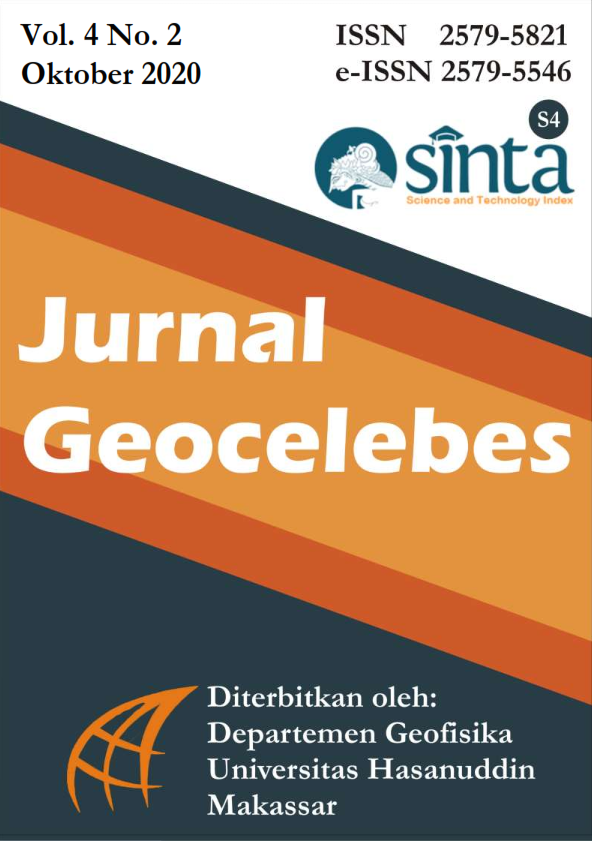FORWARD MODELLING METODE GAYABERAT DENGAN MODEL INTRUSI DAN PATAHAN MENGGUNAKAN OCTAVE
DOI:
https://doi.org/10.20956/geocelebes.v4i2.10112Abstract
The gravity method is a geophysical exploration method to measure variations in the acceleration of gravity on the surface of the earth in response to variations in rocks that exist beneath the surface. In gravity exploration requires a preliminary picture as a reference for measurement. This study aims to make forward modeling synthetic OCTAVE based using synthetic data on subsurface rock structures, so as to produce intrusion and fracture models based on differences in the value of the acceleration of gravity from one point to another on the surface of the earth. Synthetic modeling with the geological parameter approach of the study area is based on variations in the price of rock density. The model parameters used in intrusion modeling are the density value of 2.7 g/cm3 and the depth of 850 meters while the fracture modeling uses a density value of 2.7 g/cm3 with a depth of 350 meters and 360 meters and a thickness of 500 meters. From intrusion modeling, the gravity vertical component of attraction force is 0.03 mGal and in the fracture modeling the gravity vertical component of attraction force is 0.0565 mGal. Based on the results of this modeling, distance curve vs. gravity anomaly response is obtained for both cases. In the intrusion rock model obtained by the profile model with an open type down. While the fracture modeling is obtained anomalous profile curve variation which states that in the fracture area with a significant change in the direction of the curve.Downloads
References
Alimuddin., Syamsurijal Rasimeng, Kirbani Sri Brotopuspito, W. (2011). Pemodelan Struktur Geologi Berdasarkan Data Geomagnetik Di Daerah Prospek Geothermal Gunung Rajabasa. In: Seminar Nasional Sains dan Teknologi – IV. Bandarlampung. pp.197–208.
Andrew, K. (1999). Basics of Matlab and Beyond. Jakarta: Erlangga.
Budi, R. (2011). pemrograman. Bandung: Informatika Bandung.
Carrly. (1989). Matlab User’s Guide. New York: The Math Works inc.
Grandis, H. (2009). Pengantar Pemodelan Inversi Geofisika. Bandung: Institut Teknologi Bandung.
Handayani, L. dan D. D. W. (2017). Eksplorasi Gayaberat Untuk Airtanah Dan Topografi Batuan Dasar Di Daerah Serang, Banten. Riset Geologi Dan Tambang, 27(2), pp.157–167.
Hirt, C., and Kuhn, M. (2014). A band‐limited topographic mass distribution generates a full‐spectrum gravity field – gravity forward modelling in the spectral and spatial domain revisited. Journal of Geophysical Research – Solid Earth, 119, pp.3646–3661.
Irwansyah., T. Khairuman, dan N. I. (2013). No Design of Inversion Modelling 1-D Gravity Data Using a Method of Singular Value Decomposition (SVD) Based on MatlabTitle. Journal of The Aceh Physical Society, 2, pp.1–6.
Katrinavia, Yatti Pratyas., Agus Setyawan, dan S. (2015). Pemodelan Anomali Gaya Berat Akibat Curah Hujan dan Dinamika Air Tanah di Daerah Semarang. Jurnal Fisika Indonesia, 19(55), pp.42–44.
Mohr, P. J., Taylor B.N., and Newell, D. B. (2012). CODATA recommended values of the fundamental physical constants: 2010. Reviews of Modern Physics, 84, pp.1527‐1605.
Murti, M. D. dan N. (2016). Pemodelan Dua Dimensi Data Gaya Berat (Gravity) pada Zona Sesar Lembang. In: Prosiding SKF 2016, Bandung, pp.305–314.
Proaksis, J.G, and S. M. (2000). Contemporary Communication System Using Matlab. USA : Brooks/Cole.
Rasimeng, S. (2008). Analisis Sesar Gunung Rajabasa Lampung Selatan Sebagai Daerah Prospek Geothermal Berdasarkan Data Anomali Medan Magnet Total. J. Sains MIPA, 14(1), pp.67–72.
Rasimeng, S. (2011). Penentuan Curie Point Depth Data Anomali Geomagnetik Dengan Menggunakan Analisis Spektrum (Studi Kasus: Daerah Prospek Geothermal Segmen Gunung Rajabasa Lampung). In: Seminar Nasional Sains dan Teknologi – IV, Bandarlampung, pp.325–332.
Sarkowi, M. (2014). Eksplorasi Gaya Berat. Yogyakarta: Graha Ilmu.
Suntoko, Hadi, dan A. B. W. (2017). Identifikasi Patahan Pada Batuan Sedimen Menggunakan Metode Geolistrik Konfigurasi Dipole-Dipole di Tapak RDE Serpong, Banten. Jurnal Pengembangan Energi Nuklir, 19(2), pp.81–88.
Umboh, E. B. G. et. al. (2018). Forward Modeling Metode Gravity. Komputasi Geofisika 1, pp.50–59.
Downloads
Published
How to Cite
Issue
Section
License
Authors who publish with this journal agree to the following terms:
- Authors retain copyright and grant the journal right of first publication with the work simultaneously licensed under a Creative Commons Attribution License that allows others to share the work with an acknowledgement of the work's authorship and initial publication in this journal.
- Authors are able to enter into separate, additional contractual arrangements for the non-exclusive distribution of the journal's published version of the work (e.g., post it to an institutional repository or publish it in a book), with an acknowledgement of its initial publication in this journal.
- Authors are permitted and encouraged to post their work online (e.g., in institutional repositories or on their website) prior to and during the submission process, as it can lead to productive exchanges, as well as earlier and greater citation of published work (See The Effect of Open Access).



